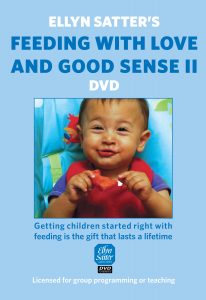

Family Meals Focus
The Ellyn Satter Institute Newsletter
The Satter Division of Responsibility in Feeding Works for Special Needs
By Ellyn Satter, MS, MSSW, Dietitian and Family Therapist
For a PDF copy of this newsletter, click here.
Through no fault of their own or anybody else, a child may not eat. Some children are exquisitely sensitive to tastes and textures, have a strong gag reflex, and throw up easily. Some have multiple food allergies. Some are diagnosed as having a sensory processing disorder, which is generally understood to mean that they react negatively to some or many tastes and textures. Some get a late start with eating because they have medical issues and/or are fed by tube during their early lives. Some are generally slow to warm up and may even be on the autism spectrum: It takes them a long time, repeated exposure, and absolutely no pressure to take an interest in new food and to learn to eat it. Some need help from an occupational therapist or speech pathologist to address problems with chewing and swallowing.
A premature child who has been tube fed
A mother writes that her son has been diagnosed with sensory processing disorder. “Carl was born prematurely and was in the hospital for three months. After he came home, it was one health procedure after another, and in the process, he didn’t learn to eat. Instead, he has been fed through a gastrostomy tube. Now he is two years old and well, and we are trying to teach him to eat. Our feeding therapist plays games with Carl to get him to open his mouth, then she slips in a little brush and rubs it around. She calls that oral desensitization. Or she slips in food. Then she ‘rewards’ Carl for ‘eating’ by letting him play with a toy. Carl doesn’t like it—he starts crying when we get near the feeding clinic. At home, we are to hold the food closely in front of his mouth until he gives in and eats a bite, then reward him. We are to put on a ‘happy face’ and give him lots of praise when he eats, and not look at or talk to him when he doesn’t. We are to rave about the food, remind him that big boys eat, and play games with the food: ‘see this little [broccoli] tree, wouldn’t it be fun to eat it?’ It takes hours, we are all miserable, and his eating is getting worse, not better.”
Feeding therapists do not have to pressure
Carl’s mother describes conventional treatment based on a child-deficit point of view: that children have to be somehow managed or manipulated to get them to eat. Conventional therapies push children to learn to eat by enticing, distracting, approving, rewarding, and even punishing. Children react to even cheerful and enthusiastic pressure by resisting, and further pressure is applied to overcome that increased resistance. Little wonder that conventional clinicians assert that “a child with a feeding problem would starve to death rather than eat foods beyond their comfort level.” Sensory issues do not make children behave in such an abnormal fashion relative to eating; pressure with feeding does.
Many feeding therapists have relieved themselves of the burden of getting a child to eat and, instead, trust the child to get themselves to eat. Trusting therapists introduce the food or device and wait a few seconds for the child to look and voluntarily open their mouth. If the child does not, the therapist absolutely takes no for an answer. Then the therapist further builds trust by keeping the child company while they play, perhaps but not even necessarily including food models and eating utensils. Then another day at another session, the therapist offers again, and again accepts the child’s opening-up or refusal.
In addition to in-office work, fdSatter-based feeding therapists support parents in following sDOR, trusting their child to eat, scrupulously avoiding any and all pressure, and containing their anxiety while they wait for their child to be ready to eat. With time and repeated neutral exposure, children eat.
For more about issues in feeding therapy, see Intervening with Pediatric Feeding Disorders.
sDOR is a powerful intervention
Feeding therapists trained in the Ellyn Satter Institute Feeding with Love and Good Sense VISION workshop begin by doing a complete assessment of the child, parents, and feeding from birth to sort out the medical, developmental, nutritional, psychosocial, and feeding dynamics issues and plan treatment that addresses all the problems. With skillful attention to the child’s particular needs and consistently applied, the Satter Division of Responsibility in Feeding (sDOR) forms the foundation for guiding parents through the process of the child’s learning to eat. As with any other child, parents do the what, when, and where of feeding, and let the child do the how much and whether of eating. With professional guidance, parents support the child nutritionally—perhaps by continuing tube-feeding—while the child ever-so-slowly, over weeks and months, learns to eat. As previously moted, any oral-motor issues can be addressed at the same time by a trust-based occupational therapist or speech pathologist.
Many children have sensory issues with feeding, but with plenty of time and no pressure, they manage their own anxiety and push themselves along to learn to eat.
Carl will get himself to eat
From the perspective of the Satter Feeding Dynamics Model (fdSatter), Carl will get himself to eat. Rather than considering Carl incapable, fdSatter considers him as fundamentally capable and helps him cope with what he is up against. He is naturally cautious about eating—he missed out on two years’ eating experience, and it is all new to him. Not only that, but much of what happened to Carl’s mouth early on was painful. In spite of it all, it is possible to trust that Carl wants to grow up—with eating as in all ways. Even the sickest child retains that drive, and, because of it, they can be trusted to manage their anxiety about eating and push themselves along at their own rate.
sDOR can’t stand alone
sDOR is trust-based intervention. To follow sDOR, parents need to understand what happened that they lost trust in their child to do their part with how much and whether of eating. Such understanding helps them to regain their trust.
Feeding struggles are complex, deep-rooted, and long-standing, and parents are frightened for their child’s well-being. Careful assessment identifies what brought parents and child to this place and allows parents to feel that they, their child, and their situation are fully understood. That detailed workup is taught in the Feeding with Love and Good Sense VISION Workshop. Without this detailed assessment, advice to follow sDOR comes across as just one more of the many partial and piecemeal bits of instruction they have been given over the years.
Feed Carl like a regular child
Encourage parents to feed Carl like he is a normal, extremely picky child—which he is. Support their patience as they give him many unpressured chances to learn to eat. As Carl gains eating capability, have a dietitian provide advice about gradually decreasing the amount and timing of the tube feeding so he can be hungry, but not starving, at meal- and snack-time.
- Include Carl in the family’s regular, family-friendly meals and snacks. Include foods that fit his ability to do it himself: to pick up, mouth, chew, and swallow.
- Trust Carl to cope with his sensory issues, including gradually developing positive attitudes about eating, getting over his fear of eating, and resolving his aversion to touching and mouthing.
Observe how Carl pushes himself along to learn to eat
Once sDOR is in place, the atmosphere at family meals will quickly become positive. That positive atmosphere sets the stage for Carl’s learning to eat a variety of food, which will take months and even years. Over that long term, parents have to remain consistent with sDOR and withstand outside interference as well as their own entirely natural, but counterproductive, impulses to speed the process along. Trying to speed things up will slow them down.
In the meantime, parents and therapists can observe the little ways Carl shows he is learning to eat. He will come willingly to the table, enjoy being there, and behave nicely. He will look at food and watch parents eat, allow the serving bowl to be by his plate, or allow food to be on his plate—and not eat it. He will put food in his mouth and take it out—again and again. Eventually he will eat. As Ellyn Satter Institute faculty member and experienced feeding therapist Pam Estes observes, he is likely to not do, not do, not do, and then he will do! Carl did it by eating a cob of sweetcorn.
Then parents and therapists can go off by themselves, shed a tear or two, and celebrate. But they mustn’t let Carl catch them at it. As far as he is concerned, his learning and growing is all in a day’s work.
Explore
For help feeding your special needs child like a regular kid, read Ellyn Satter’s Child of Mine: Feeding with Love and Good Sense.
To see what feeding looks like with “regular” children, see Ellyn Satter’s Feeding with Love and Good Sense DVD II. For home use version, click here.

More about how to feed
- Child feeding ages and stages
- Children’s eating and growth
- Childhood feeding problems
- Family meals and snacks
Related issues of Family Meals Focus
- Adoptive and foster child feeding problems
- ARFID: What is it? What does it have to do with feeding dynamics and eating competence?
- Does sDOR work in clinical care?
- Feeding neglected children mandates division of responsibility in feeding.
- Picky eating: Born or made?
- Does following sDOR mean you have to starve children to make them eat?
Intervening with Pediatric Feeding Disorders
More about understanding established feeding problems from the perspective of the Satter Feeding Dynamics Model.
Related issues of Family Meals Focus
- Does the division of responsibility in feeding work in clinical care?
- Eating competence: Food acceptance
- Picky eating: Born or made?
- Picky eating in adults: How to help
- Toddler feeding: A series of unfortunate events
- Toddler feeding: the child who won’t eat table food
- Toddler feeding: What’s the big deal?
Address food refusal wisely and well
- Avoid pressure
- Family-friendly feeding tips
- Follow Satter’s Division of Responsibility in Feeding(sDOR)
- How children become competent eaters
- How to become eating competent
- The adult picky eater
- The picky eater

